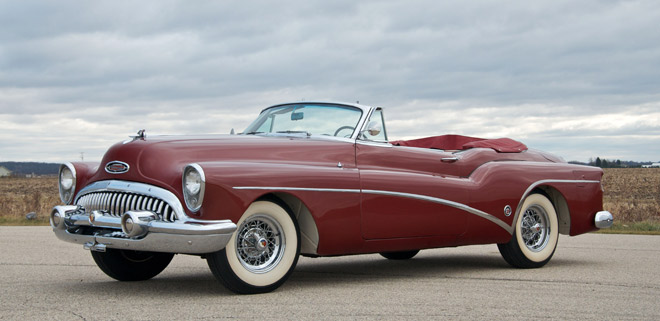* 322-ci Nailhead engine
* Automatic transmission
* Power convertible top
* Power windows
* Power antenna
* Chrome wire wheels
* Wide whitewall tires
SCM Analysis
Detailing
| Vehicle: | 1953 Buick Skylark |
| Years Produced: | 1953 |
| Number Produced: | 1,690 |
| Original List Price: | $4,596 |
| Tune Up Cost: | $150 |
| Distributor Caps: | $25 |
| Chassis Number Location: | Hinge pillar post/dash under hood |
| Engine Number Location: | Crankcase or engine block |
| Website: | http://www.members.aol.com/buick5354/ |
| Investment Grade: | B |
This 1953 Buick Skylark, Lot U75, sold for $100,700, including buyer’s premium, at Mecum Auction’s Kissimmee, FL, sale on January 29, 2012.
In 1953, GM pulled out all the styling stops, and several dream cars actually reached production. The Corvette, with a novel fiberglass body, was introduced, along with a trio of convertibles.
The Oldsmobile 98 Fiesta, priced at $5,715, was announced mid-model year and only 458 were produced.
The Cadillac Series 62 Eldorado was the production version of the 1952 El Dorado “Golden Anniversary” concept car, and it borrowed “Dagmars” from the 1951 GM Le Sabre concept car. It featured a wrap-around windshield, with a price tag of $7,750. Only 532 were produced.
The Buick Skylark was the most successful of the trio, with a production run of 1,690 cars at a price of about $5,000. In today’s new-car market, a proposed car would never get past the various committees and review boards with such limited prospects, but general managers had far more authority 50 years ago. In fact, the Skylark lived to a second year simply because a styling vice president liked the car.
A two-ton sports car?
The genesis for the Skylark is based on a questionable tale. It is suggested that Buick General Manager Ivan Wiles liked some styling touches that Chief Stylist Ned Nickles had applied to his 1951 Roadmaster, and he wanted to build “the answer to the European sports car.” This was an interesting concept for a car that would weigh in at more than two tons.
The Buick XP-300, which was a 1951 Motorama show car, is the more likely candidate for the evolution of the Skylark. It was the inspiration of Charles Chayne, Buick’s chief engineer, who wanted to design a dream car that would be fresh after 15 years.
Placing the XP-300 in production was not realistic because of high costs; however, the public’s excitement about the dream car did generate interest in offering a “sportier” Buick. The resulting prototype was based on the 1952 Roadmaster with the portholes — called VentiPorts — removed. Buick stated that if there was enough interest in the prototype, they would consider putting it in production, but it was already slated for introduction.
Hand-built touches
The tops of the doors were cut down three inches and matched the fender line — as did the shortened seats. The long sweep-spear trim gave the car the illusion of length, and the wheel openings were cut to create the appearance of a lower car.
Borrani wires were on the prototype, but they were replaced with Dayton wire wheels to keep costs down. XP-300 headlamps were added, and the top was chopped three inches to lower the silhouette of the car.
The interior was finished with narrow pleated leather that was offered in four two-toned combinations. Roxpoint nylon carpeting complemented the leather, and the new, foot-controlled Selectronic radio was standard equipment. The dash was covered with Di-Noc, a diamond-patterned material, and a unique horn button in the center of the steering wheel — with the owner’s signature —celebrated Buick’s 50th anniversary.
The 1953 Skylark featured V8 power and a 12-volt electrical system, which were both firsts for Buick. These cars were handmade in many respects, and there is little argument that they were — and still are — striking automobiles.
Values dropping — for now
The 1953–54 Skylark had relatively limited production, but few met the crusher over the years. If one is on your list, there are plenty to choose from, as a review of the SCM Platinum Database showed that 12 had crossed the auction block in 2011 alone.
Pricing these cars is another issue, as it is as precise as tacking Jell-O to the wall. In 2007, RM sold an exceptional Skylark for $495,000. In 2006, Barrett-Jackson sold one for $383,400. Prices have slid downhill ever since.
Of the 12 sold in 2011, they ranged in price from $64,350 to $206,700, and our subject car realized $100,700. They are expensive cars to restore. The hand-installed lead work, particularly behind the doors at the bottom of the window line, requires unique skills to redo properly. The rearview mirror is unique to the Skylark and is expensive to replace. In other words, money spent up front to buy the best available is a wise decision in the long run.
The values of 1952–54 Skylarks have been caught in the ebb of the 1950s American car market. They will rise again, as they are stunning, well-built cars. The price paid for this car at the 2012 Mecum Kissimmee sale shows we are at the bottom of the market. At the price paid, this car will prove to be a very wise purchase.
